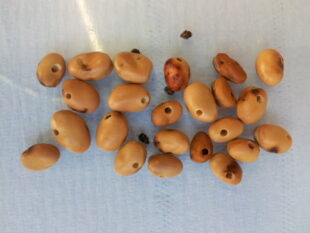Pea and bean weevil and bruchid beetle are common pests in UK legumes, impacting on both yield and quality. Great progress has been made in control of bruchid beetle damage in recent years, but weevil attacks have become more difficult to control despite chemical interventions.
In this collaborative project, supported by the Agri-Tech Catalyst, the use of a biological control agent and more targeted use of conventional crop protection is being investigated in an attempt to control beetle pests.

The pest
Damage caused by the weevil adult is visible as notching around the leaf margins, although this damage doesn’t usually significantly affect yield. Loss of yield is caused by the larval stages which feed in nitrogen-fixing root nodules of the plant. Damage caused by bruchid beetle is visible as holes in the seed, affecting quality and value to the grower.
Adult weevils are elongated beetle-like insects and 4-5mm in length. They are light grey to brown in colour with faint striping along the length of the wing cases. They have a short snout, but the elbowed antennae typical of weevils. Migration into pea and bean crops from over-wintering sites, mainly grassy, uncultivated grass margins, occurs in early spring when maximum air temperature exceeds 15°C. Newly emerged spring grown crops are most susceptible to damage, although in severe cases winter beans can be affected by adults or larvae. If leaf damage is seen, early treatment of the crop is necessary to interrupt egg-laying and reduce root nodule damage. In recent years growers have reported increased damage by this pest, despite chemical intervention.
A monitoring system, developed by Rothamsted Research, Processors and Growers Research Organisation (PGRO) and ADAS, is available which detects adults when they begin migrating in the early spring, The system comprises traps containing an aggregation pheromone lure that is highly attractive to both sexes, and is used to aid spray application decision-making.
Adult bruchid beetles are 2-3mm long with black to dark brown wing cases and white flecks on the upper surface. They migrate to bean crops from over-wintering sites, mainly standing trees and hedgerows, when temperatures reach 17-20°C, and feed on the pollen of beans before laying eggs on the pods. The eggs hatch and larvae burrow through the pod wall into the underlying seed, where they feed for several weeks. The larvae pupate and adults mature when the crop is combined, emerging from the seed to leave a hole in the seed coat. Often there are other blemishes on the seed coat associated with larval entry. PGRO manages a network of monitoring sites using traps that contain plant volatile lures, based on bean floral aromas, that were developed at Rothamsted Research and Oecos.

The project
The £765,000 Agri-Tech Catalyst project is led by PGRO with Rothamsted Research, Oecos, Exosect and BASF also part of the consortium. The consortium is now undertaking work to test the efficacy of a novel biological control agent against pea and bean weevils, with a secondary target for bruchid beetle control. In addition, the project will look at more targeted use of conventional crop protection products.
In more detail, using a weevil pheromone, and plant volatiles for bruchid beetle, beetles will be lured to a device where they will be coated with spores of a naturally occurring insect fungal disease, Beauveria bassiana. The spores and the attractants will be prepared in a formulation that is electrostatically charged and sticks to the beetles. When they leave the device they will spread the disease to other beetles like them. This will reduce pest numbers and damage to the crops without damage to the environment or other beneficial insects.
The project is jointly funded by industry and government - £565,000 is provided by the Agri-Tech Catalyst, with industry partners PGRO, BASF, Oecos and Exosect providing £200,000. The partners started detailed work on the project in October 2014 with research and investigations being carried out over the next four years.
Work is already underway to formulate the lures with the electrostatic powder and design the inoculation station, so the project is ready for field trials to commence in the spring this year.
Becky Ward, Processors & Growers Research Organisation

Recent Comments